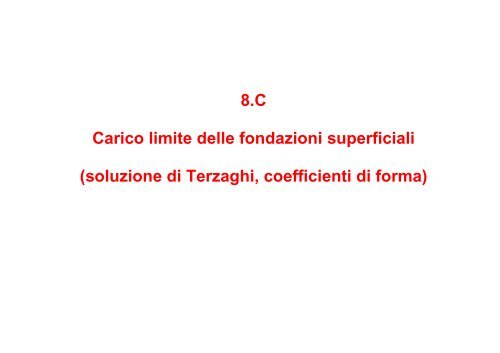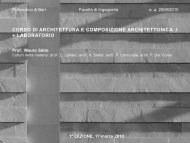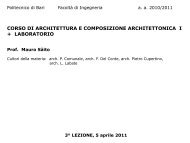8.C Carico limite delle fondazioni superficiali (soluzione di Terzaghi ...
8.C Carico limite delle fondazioni superficiali (soluzione di Terzaghi ...
8.C Carico limite delle fondazioni superficiali (soluzione di Terzaghi ...
Create successful ePaper yourself
Turn your PDF publications into a flip-book with our unique Google optimized e-Paper software.
<strong>8.C</strong><br />
<strong>Carico</strong> <strong>limite</strong> <strong>delle</strong> <strong>fondazioni</strong> <strong>superficiali</strong><br />
(<strong>soluzione</strong> <strong>di</strong> <strong>Terzaghi</strong>, coefficienti <strong>di</strong> forma)
• Calcolo del carico <strong>limite</strong> q lim per rottura generale<br />
w<br />
w
<strong>Carico</strong> Limite: Formula trinomia <strong>di</strong> <strong>Terzaghi</strong><br />
1. Rottura generale<br />
2. Fondazione nastriforme indefinita<br />
3. Terreno a comportamento rigido-plasitico con criterio <strong>di</strong> rottura alla Mohr-<br />
Coulomb (τ f = c' + σ' tag φ‘)<br />
4. Sulla fondazione agiscono carichi verticali centrati<br />
5. Piano campagna e piano <strong>di</strong> posa orizzontali<br />
6. Terreno omogeneo
<strong>Carico</strong> Limite: Formula trinomia <strong>di</strong> <strong>Terzaghi</strong><br />
• <strong>Carico</strong> Limite o capacità portante<br />
1<br />
q = c⋅ N + B⋅γ ⋅ N + γ ⋅D⋅N 2<br />
lim c 2 γ 1 q<br />
• c = coesione (c = c u a B.T., c = c’ a L.T.)<br />
• Nc, Nγ, Nq coefficienti <strong>di</strong> capacità portante <strong>di</strong>pendenti da φ (φ=0 a B.T., φ=<br />
φ’ a L.T.)
1+<br />
senϕ<br />
( π⋅tgϕ) Nq = e Nc = ( Nq − 1) ctg ϕ Nγ= 2( Nq<br />
+ 1) tgϕ<br />
1−<br />
senϕ
• Nel calcolo del carico <strong>limite</strong> <strong>di</strong> <strong>fondazioni</strong> rettangolari, quadrate o<br />
circolari la relazione <strong>di</strong> <strong>Terzaghi</strong> si mo<strong>di</strong>fica nella:<br />
1<br />
q = c⋅N ⋅ s + B⋅γ ⋅N ⋅ s + γ ⋅D⋅N ⋅s<br />
2<br />
lim c c 2 γ γ 1 q q<br />
• s c, s γ, s q sono coefficienti <strong>di</strong> forma<br />
• Per <strong>fondazioni</strong> quadrate o rettangolari (con B ≤ L):<br />
• Per <strong>fondazioni</strong> circolari:<br />
sc = q<br />
γ<br />
1 . 3 s = 1 s = 0.<br />
6<br />
sc = sq<br />
s<br />
γ<br />
= 1−<br />
0.<br />
3<br />
= 1+<br />
0.<br />
2<br />
B<br />
L<br />
B<br />
L
8.D<br />
<strong>Carico</strong> <strong>limite</strong> <strong>delle</strong> <strong>fondazioni</strong> <strong>superficiali</strong> in<br />
con<strong>di</strong>zioni non drenate e in con<strong>di</strong>zioni<br />
drenate
• Per i terreni a grana fine in con<strong>di</strong>zioni NON DRENATE: analisi in<br />
tensioni totali<br />
lim<br />
⎧c=<br />
c ⎧<br />
u<br />
Nc= 5.7<br />
⎪ ⎪<br />
⎨ϕ= 0 ⎨Nγ=<br />
1<br />
⎪γ γTOT<br />
! ⎪<br />
⎩ =<br />
⎩N<br />
q = 0<br />
q = γ<br />
⋅ D ⋅1⋅<br />
5. 7 ⋅Cu<br />
⋅ sc<br />
+ 1<br />
s<br />
q
• Per tutti i terreni in con<strong>di</strong>zioni DRENATE: analisi in tensioni<br />
efficaci<br />
⎧c<br />
= c'<br />
⎪<br />
⎨ = ϕ'<br />
⎪<br />
⎩γ<br />
= γ'<br />
= γ −γ<br />
w<br />
⎧N<br />
⎪<br />
⎨N<br />
⎪<br />
⎩N<br />
ϕ γ<br />
c<br />
q<br />
funzione <strong>di</strong> ϕ'
• Per superficie <strong>di</strong> falda al piano campagna:<br />
1<br />
q = c'⋅N ⋅ s + B⋅γ ' ⋅N ⋅ s + γ '⋅D⋅N<br />
⋅s<br />
2<br />
lim c c 2 γ γ 1 q q<br />
' '<br />
' ' '<br />
p.c = p.f
• Per superficie <strong>di</strong> falda al piano <strong>di</strong> posa:<br />
1<br />
q = c'⋅N ⋅ s + B⋅γ ' ⋅N ⋅ s + γ ⋅D⋅N ⋅s<br />
2<br />
lim c c 2 γ γ 1 q q<br />
' ' '<br />
p.p = p.f<br />
• Per superficie <strong>di</strong> falda a profon<strong>di</strong>tà maggiore <strong>di</strong> D+B<br />
1<br />
q = c'⋅N ⋅ s + B⋅γ ⋅N ⋅ s + γ ⋅D⋅N ⋅s<br />
2<br />
lim c c 2 γ γ 1 q q
• Limiti <strong>di</strong> applicabilità della relazione <strong>di</strong> <strong>Terzaghi</strong>: a lungo termine<br />
la relazione prevede una <strong>di</strong>pendenza lineare tra qlim e B<br />
• In realtà ciò è vero per B ≤ 3 m. Per B >3 m, il meccanismo <strong>di</strong><br />
rottura è <strong>di</strong>verso da quello ipotizzato da <strong>Terzaghi</strong> rendendo non<br />
più conveniente l’allargamento della fondazione al fine <strong>di</strong> un<br />
aumento <strong>di</strong> qlim qlim (kPa)<br />
L.T.<br />
• Cautelativamente, B max = 3 m<br />
B = 3 m<br />
<strong>Terzaghi</strong><br />
realtà<br />
B (m)




